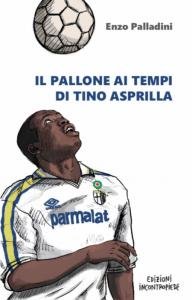Il pallone ai tempi di Tino Asprilla
10 Dicembre 2021
di Stefano Olivari

Come sarebbe stata la carriera di Faustino Asprilla se ai suoi tempi fossero esistiti Instagram ed i vari social network? Enzo Palladini si pone questa giusta domanda all’inizio del suo Il pallone ai tempi di Tino Asprilla, libro appena uscito per Edizioni In Contropiede e che nonostante l’età abbiamo letto proprio con lo stupore di un ragazzo di oggi, che considera Asprilla uno dei tanti o che magari non l’ha mai sentito nominare. La risposta nelle pagine di una biografia che non è una biografia, ma un accavallarsi di flash sulla vita di un personaggio ai confini della realtà, anche di quella colombiana.
Asprilla è stato tutt’altro che un ragazzino prodigio, anche se le sue doti tecniche ed atletiche sono evidenti, così nel 1992 Giambattista Pastorello, il direttore sportivo del Parma di Tanzi, riesce a battere i tiepidi interessamenti di altri club e ad acquistarlo dal Nacional di Medellin, previo assenso di Pablo Escobar, grande ammiratore di Asprilla nonché finanziatore del club.
Il libro racconta bene l’arrivo del ventitreenne Asprilla in una realtà come quella di Parma ed in generale quella italiana. Sposato giovanissimo, ma con il matrimonio certo non ostacolo ad una vita notturna incredibile anche per un calciatore, Asprilla inizia a farsi conoscere comprando occhiali da sole da mandare ai suoi amici in Colombia (dove ne vendono di uguali, ma lui ritiene che quelli dei negozi italiani siano migliori) e soprattutto centinaia di rubinetti. Sì, proprio rubinetti per i bagni. Anche quelli spediti in patria, insieme ad auto ed altro.
Palladini è efficace nel raccontare, grazie anche a sue interviste dirette (a Pastorello e Nevio Scala, soprattutto), l’inserimento di questo alieno, uno dei cinque stranieri (ma per i regolamenti dell’epoca potevano andare a referto solo in tre) del Parma 1992-93 insieme a Taffarel, Grun, Brolin e all’indimenticato Sergio Berti. Proprio la gestione di Asprilla fuori dal campo è causa di tensione fra Scala ed il club, con i due episodi più famosi della sua vita al Parma accaduti nel giro di poche settimane.
21 marzo 1993: a San Siro un calcio di punizione di Asprilla, rubato ad Osio (il colombiano gli dice che così vuole Scala, ma non è vero), mette fine ad un’imbattibilità del Milan di Capello che dura da quasi due anni. 6 aprile 1993: semifinale di andata di Coppa delle Coppe a Madrid, il Parma batte l’Atletico 2-1 con due gol di uno scatenato Asprilla, ammonito e squalificato per il ritorno. In questo momento è forse l’attaccante più forte del mondo.
Asprilla chiede a Pastorello un permesso per tornare qualche giorno in Colombia, perché la mamma è malata. Vera la malattia della mamma, che morirà poco tempo dopo, falsa la promessa di rimanere pochi giorni perché si rende presto irreperibile e riprende una vita notturna mai interrotta. In una di queste notti colombiane (ma non è che quelle parmensi o milanesi siano più tranquille) stando in piedi sull’auto di un amico prende a calci un autobus, così, per divertimento, e si fa male con la scheggia di un finestrino.
Un po’ perché ha dolore e un po’ per punirlo Scala lo esclude dalla finale poi vinta con l’Anversa, che molti ritengono il punto più alto del ‘vero’ Parma, anche se poi nell’era Tanzi si sarebbe vinto molto altro. Asprilla giocherà altre stagioni per il Parma e con Scala, ma non sarà più quello di prima pur segnando abbastanza ed offrendo fiammate di talento purissimo.
Il libro è pieno di aneddoti strepitosi, che non vogliamo bruciare. Il più divertente, fra quelli raccontabili (perché la vera biografia estrema sarebbe quella dell’amico Crippa…), quello in una discoteca milanese, guidando una squadra di quindici travestiti all’inseguimento di Fernando Couto con l’obiettivo di tirargli i capelli davanti ad una esterrefatta Cindy Lauper. Il più italiano, in senso deteriore, quello raccontato da Pastorello, con il prefetto di Parma che promette al club di far seguire Asprilla da un carabiniere 24 ore su 24 (complimenti al prefetto e anche al carabiniere, visti i risultati), per tenere alto il suo rendimento in campo.
Ma al di là degli episodi il senso del libro è chiaro: ad Asprilla non sono mancate fortuna ed opportunità, è soltanto che non gliene fregava niente ed ha fatto il minimo, per uno del suo talento. Non abbastanza maledetto per essere George Best, non abbastanza bambino per essere Gascoigne, alla fine è stato soltanto Asprilla ed in fondo nel dopo calcio ha dimostrato più intelligenza che negli anni giovanili. Meglio così che il contrario.

What would Faustino Asprilla’s career have been like if Instagram and the various social networks had existed in his heydays? Enzo Palladini asks this question at the beginning of his book Il pallone ai tempi di Tino Asprilla (The ball at the time of Tino Asprilla), which has just been published by Edizioni In Contropiede and which, despite our age, we read with the astonishment of a young man of today, who considers Asprilla one of the many or who has never heard of him. The answer in the pages of a biography that is not a biography, but an overlapping of flashes on the life of a character on the borders of reality, even the Colombian one.
Asprilla was anything but a child prodigy, even if his technical and athletic skills were evident, so in 1992 Giambattista Pastorello, the sports director of Tanzi’s Parma, managed to beat off the lukewarm interest of other clubs and buy him from Nacional of Medellin, with the consent of Pablo Escobar, a great admirer of Asprilla and financier of the club.
The book tells the story of the 23-year-old Asprilla’s arrival in Parma and, more generally, in Italy. Married very young, but with his marriage certainly not an obstacle to an incredible nightlife even for a footballer, Asprilla began to make a name for himself by buying sunglasses to send to his friends in Colombia (where they sell the same ones, but he believes that those in Italian shops are better) and above all hundreds of taps. Yes, taps for the bathroom. Even those sent back home, along with cars and other things.
Palladini is effective in recounting, thanks also to his direct interviews (with Pastorello and Nevio Scala, above all), the insertion of this alien, one of the five foreigners (but according to the regulations of the time only three could play) of Parma 1992-93 along with Taffarel, Grun, Brolin and the unforgettable Sergio Berti. Asprilla’s management off the field caused tension between Scala and the club, with the two most famous episodes of his life at Parma happening in the space of a few weeks.
21st March 1993: at San Siro a free kick by Asprilla, stolen from Osio (the Colombian tells him that’s how Scala wants it, but it’s not true), puts an end to an unbeaten run for Capello’s Milan that lasted almost two years. 6th April 1993: Cup Winners’ Cup semi-final first leg in Madrid, Parma beat Atletico 2-1 with two goals from a wild Asprilla, who was cautioned and disqualified for the return leg. He was cautioned and disqualified for the return leg. At this moment he is perhaps the strongest striker in the world.
Asprilla asks Pastorello for permission to return to Colombia for a few days because his mother is ill. His mother’s illness is true and she will die a short time later, but the promise to stay for a few days is false because he soon disappears and resumes a nightlife he never stopped. On one of these Colombian nights (but those in Parma or Milan are no more peaceful), standing on a friend’s car, he kicks a bus, just for fun, and hurts himself with a splinter of a window.
Partly because he was in pain and partly to punish him, Scala excluded him from the final that he then won against Antwerp, which many consider to be the high point of the ‘real’ Parma, even though much more would be won during the Tanzi era. Asprilla will play other seasons for Parma and with Scala, but he won’t be the same as before even if he scored enough and offered flashes of pure talent.
The book is full of amazing anecdotes, which we do not want to burn. The funniest, among the ones that can be recounted (because the real extreme biography would be that of our friend Crippa…), was the one in a Milanese disco, leading a team of fifteen transvestites in pursuit of Fernando Couto with the aim of pulling his hair in front of an astonished Cindy Lauper. The most Italian, in the worst sense, is the one told by Pastorello, with the prefect of Parma promising the club to have Asprilla followed by a carabiniere 24 hours a day (congratulations to the prefect and also to the carabiniere, given the results), to keep up his performance on the pitch.
But beyond the episodes, the sense of the book is clear: Asprilla didn’t lack luck and opportunities, it’s just that he didn’t give a damn and did the minimum, for someone of his talent. Not cursed enough to be George Best, not childish enough to be Gascoigne, in the end he was just Asprilla and after football he showed more intelligence than in his youth years. Better that way than the other way round.
Translated with www.DeepL.com/Translator (free version)





Commenti Recenti